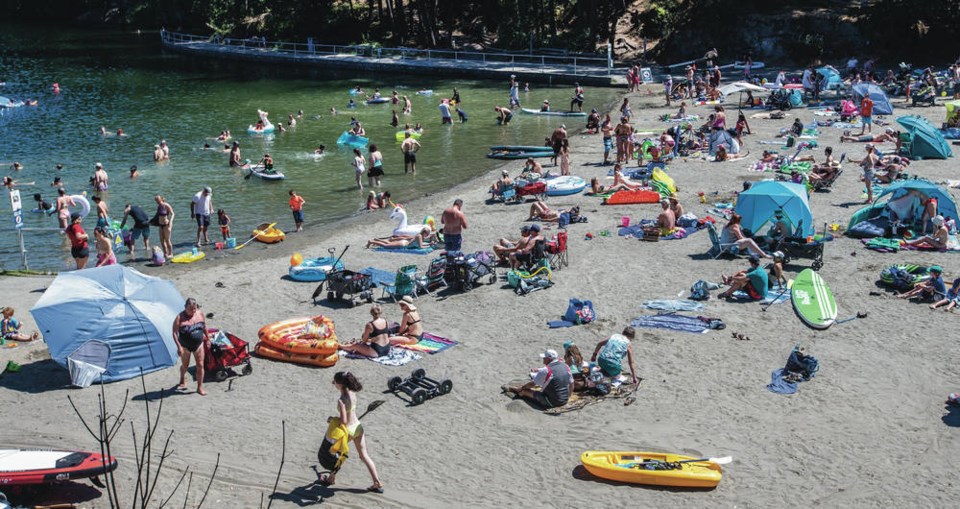Oppressive heat pounded down on the Island Saturday as temperatures rose to record highs, with no relief for at least another two days.
The temperature at Victoria International Airport hit 35.6 C between 6 and 7 p.m., smashing a record of 35 C from 1925 for one of the hottest days ever for the region as a “heat dome” — an intense high-pressure system more common to Mexico — settled over much of the province.
Beaches and lakes were crowded, and water parks were filled with kids and parents trying to beat the heat.
Thetis Lake was crammed full of paddleboarders and people swimming.
Brasserie l’Ecole, a French bistro in downtown Victoria, said it wasn’t opening Saturday evening after temperatures got “dangerously high” in its kitchen Friday.
Island Health shut vaccination clinics at Eagle Ridge Arena in Langford and another at the Cowichan Lake Sports Arena due to “extreme heat.” It said everyone with appointments will be contacted to re-book “as soon as possible.”
Another vaccination clinic at the Aggie Hall in Ladysmith was closed due to lack of air conditioning, and appointments through to July 3 are being shifted to the Cedar Community Hall, about 12 kilometres away.
The Saanich Fire Department quickly extinguished a grass fire on a median along Blanshard Street at Vernon Avenue on Saturday afternoon. The cause wasn’t immediately known, but conditions are crispy dry and the province issued camp fire bans this week.
Temperatures are expected to go even higher today.
A warning from Environment Canada said the Island could expect temperatures of up to 38 C, with humidex values in the high 30s and low 40s, making it feel even more oppressive.
A forecast for the University of Victoria area is for 38 C today and 39 C on Monday, according to Environment Canada.
By late Saturday afternoon, Port Alberni, Duncan, Ladysmith and Shawnigan Lake had all exceeded 37 C. Nanaimo was at 37.2 and Victoria at 35.
A reading at Cultus Lake in the Fraser Valley reached a sizzling 40.6 C.
Several Island temperature records had already fallen after Friday’s heatwave — Victoria airport hit 34.1, the Malahat 33.5, and Cowichan 32.9.
At the Beacon Drive-In, people lined up for soft-serve ice cream. A manager said almost 500 customers were served by mid-afternoon, and she expected to “get slammed” in the evening as more people emerged from their homes or started coming off the beaches at Dallas Road.
Health officials are warning people to limit their time outdoors and avoid strenuous activities. It’s also important to drink plenty of water, wear hats, check in with the elderly and keep pets at home out of the sun and off hot pavement.
Saanich police were out in a patrol boat on Elk Lake, and reported in a Twitter message that “it was busy.” “Thanks to all the responsible boaters and lake users we met … plus one horse who was cooling off with a swim.”
Meanwhile, an air quality advisory was put into effect for eastern parts of Metro Vancouver and the central Fraser Valley amid the heat wave.
The 21 municipalities in Metro Vancouver said the advisory was prompted by high concentrations of ground-level ozone, which forms when pollutants from burning fossil fuels react with sunlight.
Ground-level ozone is usually highest from mid-afternoon to early evening and can be particularly concerning for people with underlying health conditions and respiratory infections, such as COVID-19, as well as pregnant women, children, outdoor workers, older adults and people who don’t have homes.
Environment Canada rated the air quality index at a moderate risk for both Vancouver and Victoria on Saturday — rating both at a level 5. The index ranges on a scale of one to 10 by taking samples from pollution monitors.
Temperature inversions and the lack of winds can lead to higher concentrations of pollutants, which can be harmful to those with underlying health conditions.
Heat warnings cover all but the western and northwestern edges of B.C., as well as most of Alberta and parts of Saskatchewan, Yukon and the Northwest Territories.



